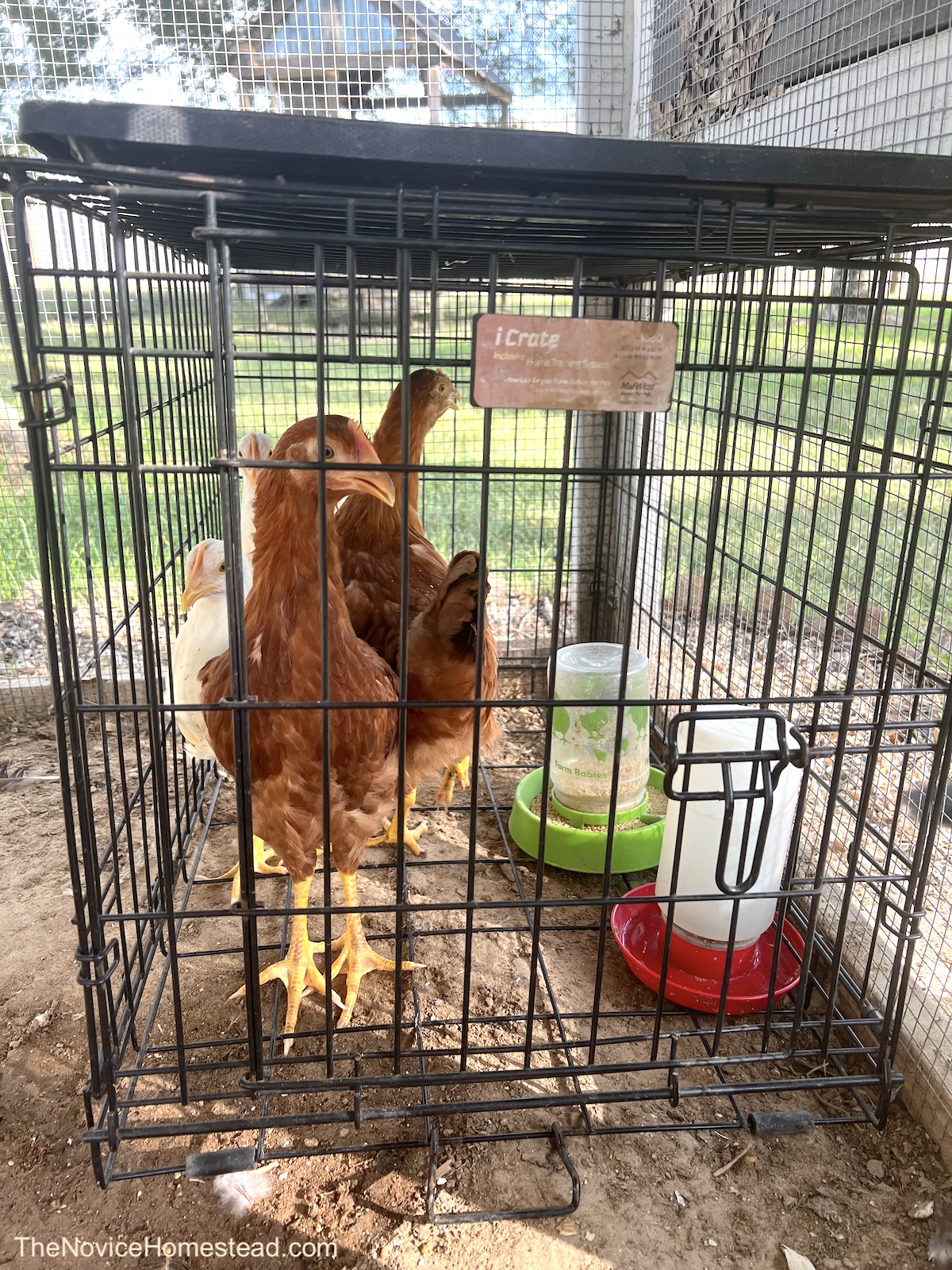Introducing new chickens to an existing flock can be tricky, but if you follow these simple tips, you can help new chickens integrate into your flock smoothly and without problems.

Pecking order is a real thing and if you’ve ever introduced new birds to a flock, you’ve likely seen it in action. Chickens will often peck at or bully new birds to show them who is boss. The new birds will have to figure out where they fit into the established social order.
3 Strategies For Introducing New Chickens To A Flock
Because you are disrupting an established order, there will always be an adjustment period when you add new birds to your flock. However, with planning and patience, you can help to ensure a smoother transition and prevent unnecessary injuries to your new flock members.
1. Just Do It
There’s one school of thought that says the best way to introduce new birds to a flock is just to go ahead and put them in the coop. Kind of like ripping a band-aid off, there is no planning, no waiting, you just get it done and see what happens.
This is not my recommendation and I’ll tell you why.
The first time we introduced a couple new birds to our older girls, we just put the new hens into the run with the flock. They had been quarantined first, but out of sight of the flock because I didn’t have a separate outdoor run for them. I figured since it was a small flock, it wouldn’t be a big deal.
However, the flock gave the new ladies a hard time for a couple weeks. There was plenty of flighting, plenty of pecking, and a little blood. I don’t think it was a good experience for anyone! The older hens were obviously stressed and asserting their dominance, the new birds got picked on mercilessly, and I was totally stressed trying to keep everyone from hurting each other.
Yes, the new girls eventually became part of the flock and they stopped fighting with each other. But why stress everyone out if you don’t have to? A little extra time and preparation makes a big difference!
2. Let Everyone Get To Know Each Other First…From A Distance
This method involves letting the established flock get to see the new birds, without being able to touch them or interact with them physically.
After quarantining, move your new birds to an adjacent coop or run so your older birds can see them. You can leave them like this for a few days or up to 2 weeks. By that time everyone is bored with each other and you can bring the new girls into the main coop.
If you don’t have separate coops or runs, you can try the method we used. I took one of our extra dog crates (large size) and put the new birds inside the crate. Then I put the crate inside the chicken’s run. This allowed the ladies to get to know each other for a few days, but not be able to get to each other. At night, we moved the crate inside the coop, then in the morning we brought it back out to the outdoor run. We did this for about 4 days.
That way when we integrated them into the flock, they already “knew” each other and didn’t fight.
This method was very successful for us and it is how I plan to introduce any new flock members in the future.

3. Introduce New Flock Members At Night
Some chicken owners swear by this trick, but I have not personally tried it because I like to be able to see what is going on.
To do this, you would wait until night time when your birds are in the coop roosting for the night. Then you would place the new birds inside the coop. Since the other birds would be groggy from sleep, they are less likely to fight. Then when they wake up, the new birds are already there and they can just go on about their day.
How Long Does It Take For Hens To Accept New Hens?
This varies depending on the personality of your birds. However, it usually takes at least 2-4 weeks for the existing flock to fully accept new members as one of their own. It may take even longer for them to truly bond and become friendly, rather than just tolerating each other.
More Tips For Successfully Adding New Chickens To Your Flock
- Quarantine First – Always quarantine new birds away from your flock for at least 2 weeks. This is to make sure that the new birds are not sick before introducing them. You want to quarantine them in a separate area (not a dog crate in the run) and not somewhere where they will have contact with the same surfaces or breathe the same air.
- Make Sure They’re Close In Age – If you’re introducing juvenile hens to your flock, you want to make sure that they are big enough to hang with the older birds. I’ve always waited until at least 12-14 weeks to start introductions, so the younger birds won’t be seriously harmed if an older bird tries to pick on them. You also want them to be able to eat the same food.
- Always Introduce Multiple Birds Together – If at all possible, you want to introduce multiple birds, versus a single chicken. They will form a “mini flock” so they have friends and they will have strength in numbers. The rest of the flock will be less likely to try to bully if the new flock is similar in size. They may kind of coexist for a few weeks before they all bond together to make a cohesive big flock.
- Provide Extra Food and Water – Even if no one is hurting each other, the established flock can bully new members in less obvious ways. They can block the new hens from accessing food, so you want to make sure that there are extra feeders and waterers so that the older birds can’t block the new birds from eating or drinking.
- Avoid Overcrowding – Make sure the coop is not too crowded, as a coop that is too small will increase the odds of fighting. As a general rule of thumb, a coop should have 4 square feet of space for each bird and a run should have 8 square feet per bird. Each chicken also needs 10-12 inches of roost space at night, so if you’re adding new birds, you may need to expand your run or add more roosting bars accordingly. Overcrowding can increase the chance of fighting.
- Keep an Eye on Things – During an introductory period, you want to check on the flock more than you would usually. If you see bullying behavior, you can try to distract the chickens or discourage them from this behavior. Though they will likely pick it back up when you leave, you may be able to offer the new birds some respite for a few minutes while you are present. Kind of like when a parent or teacher is in the room, the kids behave better.
- Be Patient – It can take time for the flock to fully accept new members. I also remind myself that chickens don’t have human feelings and that establishing the new pecking order is just part of their process. Chickens do what chickens do!
More Tips For Raising Chickens:
- How to Tell a Hen from a Rooster
- Guide to Raising Baby Chicks
- What is Pasty Butt in Baby Chicks?
- When Do Chickens Start Laying Eggs?
- How Often Do Chickens Lay Eggs
- How Cold is Too Cold for Chickens to be Outside?
- Farm Fresh Eggs 101
- How to Keep Chickens Cool in the Heat
- How to Keep Snakes Out of a Chicken Coop
- How to Keep Chickens From Eating Their Own Eggs
- What is Fowl Pox?
- How to Keep Flies Out of a Chicken Coop